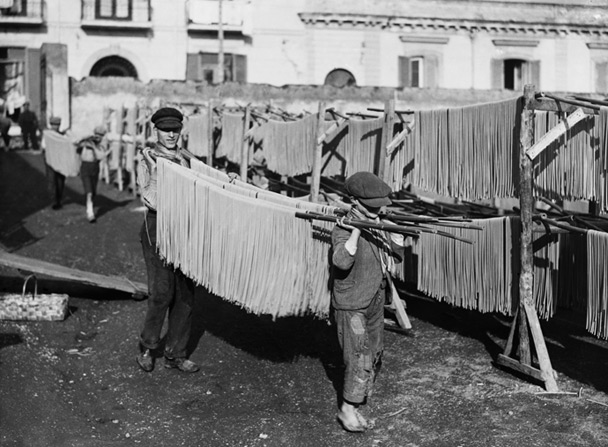Agnolotti, banh trang, capellini, ditalini… The many pastas in your kitchen have traveled a long road. Soon after early man began to plant grain, woman began to grind flour, shape or cut lumps of dough, and throw them in the soup. Thus was pasta “invented” at different times and in different parts of Asia, the Middle East, and the Mediterranean. Scholars and others have traced—and imagined—lines of migration and influence, but they look more like fusilli than spaghetti. Along the journey from prehistoric dumpling to tagliatelle al ragù, neat timelines are few; the most rewarding route will be a tour of scattered highlights.
Sometimes pasta’s story has to be ferreted out of language. An ancient Greek word meaning cakes (itria) survives as tria, a flat noodle of southern Italy. Forms of the word are found in Hebrew, Aramaic, and Arabic signifying some sort of boiled dough or noodle, but it’s likely that the dish changed over time at least as often as the spelling did. The most famous occurrence comes from the Moroccan geographer al-Idrisi, writing in Arabic in the 12th century: In Trabia, near Palermo, Sicily, “…they make a food of flour in the form of strings [itriyya] in quantities such as to supply in addition to the towns of Calabria, those of the Muslim and Christian territories.” The passage is hardly proof that the medieval Sicilians “invented” pasta, but it is widely cited to support the view that they were the first to manufacture and export dry pasta in an organized way.
Some scholars believe pasta was consumed in B.C. Greece or Italy, but it’s a stretch. The products in question seem to have been more matzo-like than pasta-like, and the Etruscan tomb reliefs often cited as “evidence” are now considered to illustrate parts of a board game, not pasta-making equipment. Still, there is food for thought here. The word lasagna is credibly (but not universally) traced to laganum, a flat oil cake that could be dried, broken, and used to thicken soup or layered, lasagna-like, with meat. When the Roman poet Horace looks forward to a humble bowl of chickpeas, leeks, and lagana, who can fail to think of pasta e ceci?
Very like lagana were wafers called tracta, from the Latin verb to drag or draw (trahere)—like tirare, the word used in Italian today for rolling dough. Present-day Italian lagane are flour-and-water pasta ribbons, and the word laganaturo survives to mean “rolling pin”. Archaeobotany (which means just what it sounds like) has provided evidence that the ancient Romans had and used durum wheat—the pride of Sicily, the grain used in Trabia’s itriyya, and still today the only form used in fine dried pasta—among other types.
Persia was consuming ribbon-shaped noodles—rishta—by at least the 10th century, and 13th-century recipe instructions call for rolling a sheet of dough and cutting through it to make the strips, a technique familiar to any Bolognese housewife. And the hat-shaped Persian stuffed pasta joshparah, uncannily like the Italian cappelletto, indirectly influenced Russia’s pelmeni.
Clearly none of this has anything to do with Marco Polo, often and erroneously credited with introducing spaghetti to Italy from China. He left Venice in 1271 and returned in 1295, and contrary to folklore, he recognized the Chinese noodles he found on his travels as forms of pasta, with which he was already familiar. In fact, the name pasta is first recorded in 1244, and maccheroni in 1279, both in Genoa.
Still, radiocarbon dating proves that the Chinese have indeed been making noodles for at least 4,000 years. An overturned clay bowl unearthed at Lajia, a Late Neolithic site in northwestern China, contained well-preserved millet noodles, about an eighth of an inch in diameter and 20 inches long. According to the excavators, the noodles resemble the traditional Chinese la-mian variety, made by pulling and stretching dough by hand. The persistence of the technique and the immutability of the long, straight shape are offset by the variety of materials later used: wheat in northern China and rice in the south, of course, but also beans and tapioca.



 Pinterest
Pinterest


